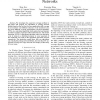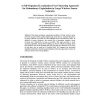226 search results - page 12 / 46 » On Connected Multiple Point Coverage in Wireless Sensor Netw... |
WINET
2011
13 years 3 months ago
2011
Sleep scheduling, which is putting some sensor nodes into sleep mode without harming network functionality, is a common method to reduce energy consumption in dense wireless sensor...
GLOBECOM
2007
IEEE
14 years 3 months ago
2007
IEEE
—Network lifetime is a critical issue in Wireless Sensor Networks. It is possible to extend network lifetime by organizing the sensors into a number of sensor covers. However, wi...
MOBICOM
2005
ACM
14 years 2 months ago
2005
ACM
In old times, castles were surrounded by moats (deep trenches filled with water, and even alligators) to thwart or discourage intrusion attempts. One can now replace such barrier...
ICCCN
2008
IEEE
14 years 3 months ago
2008
IEEE
—We investigate the p-percent coverage problem in this paper and propose two algorithms to prolong network lifetime based on the fact that for some applications full coverage is ...
GI
2008
Springer
13 years 9 months ago
2008
Springer
: This paper investigates organization problems of large wireless sensor networks. In spite of their random deployment, nodes have to organize themselves as energy efficient as pos...


